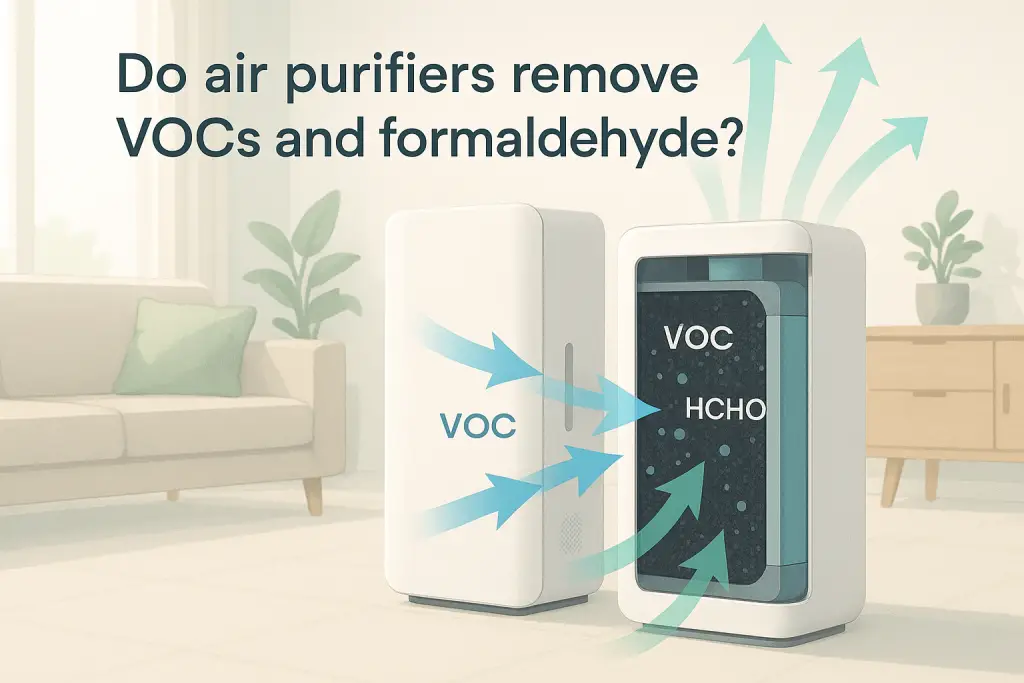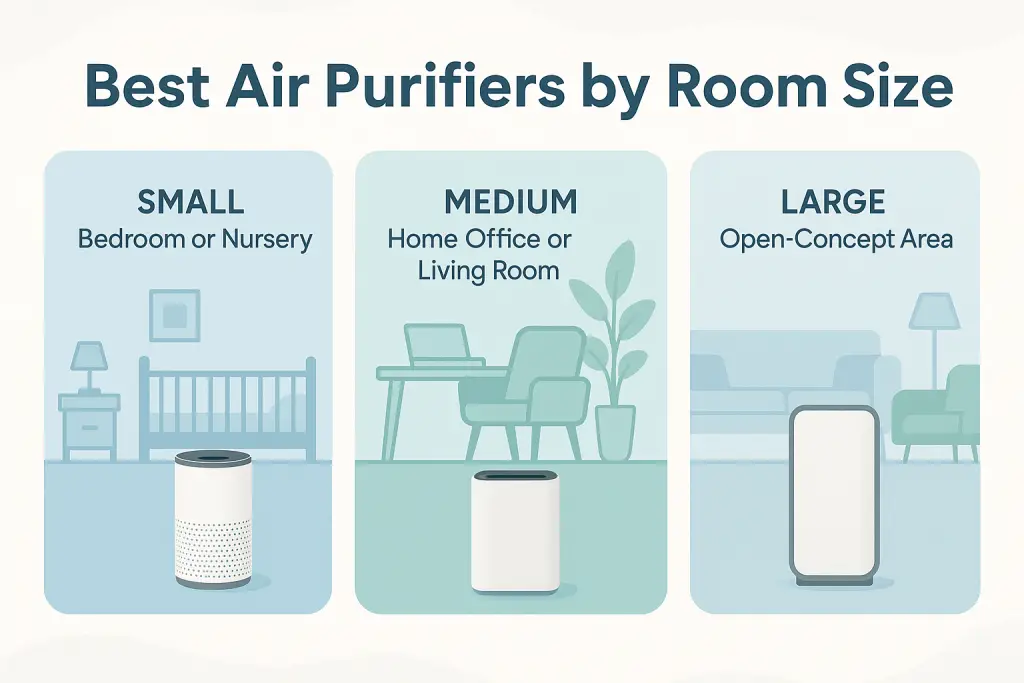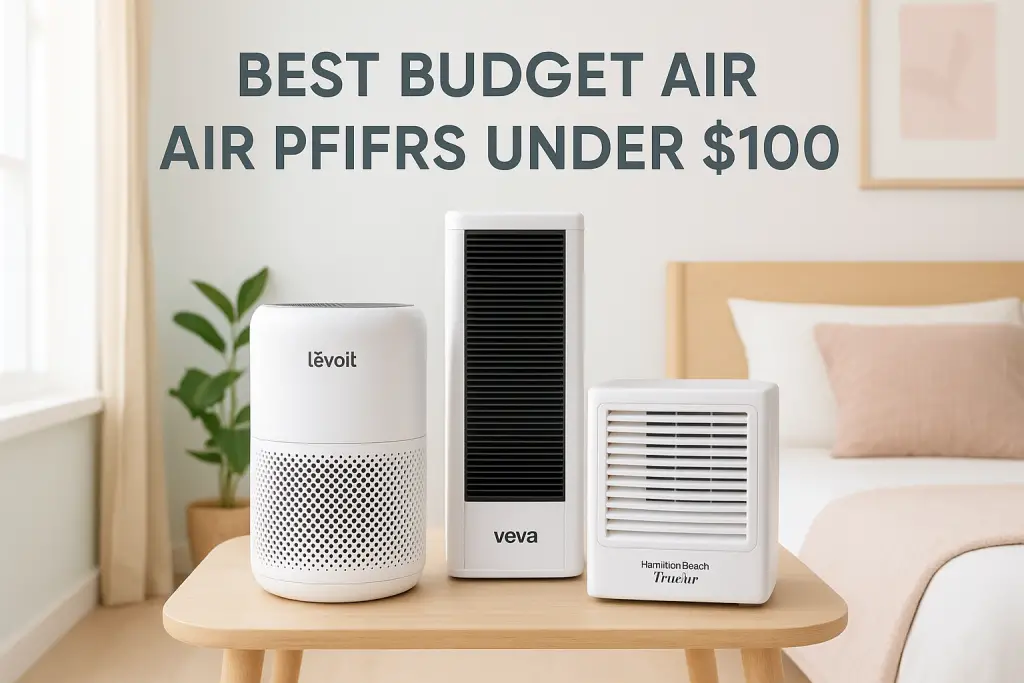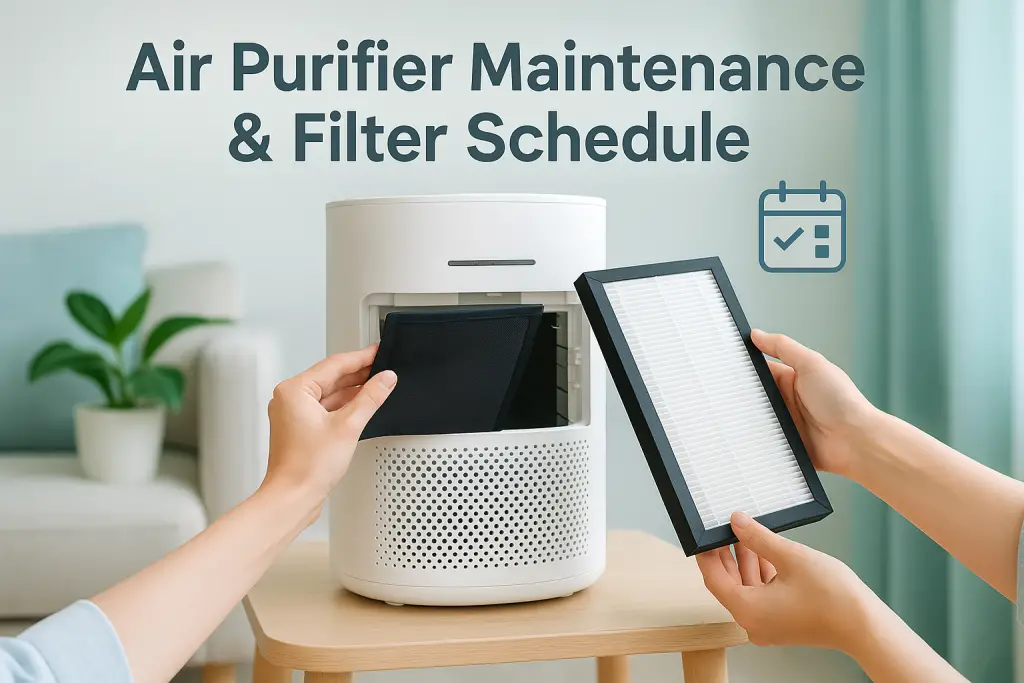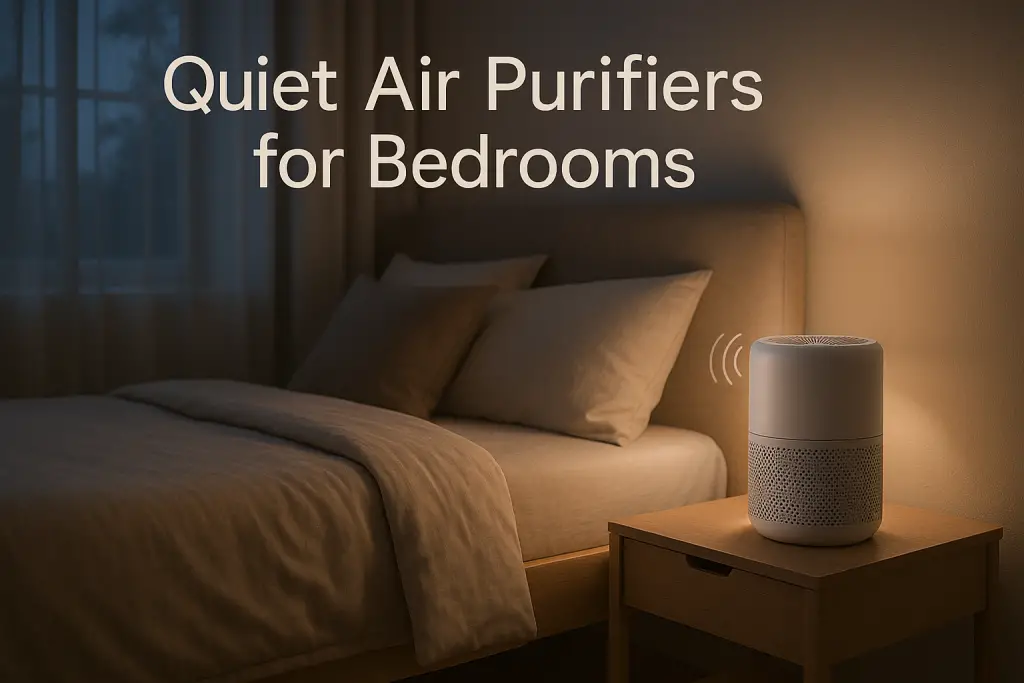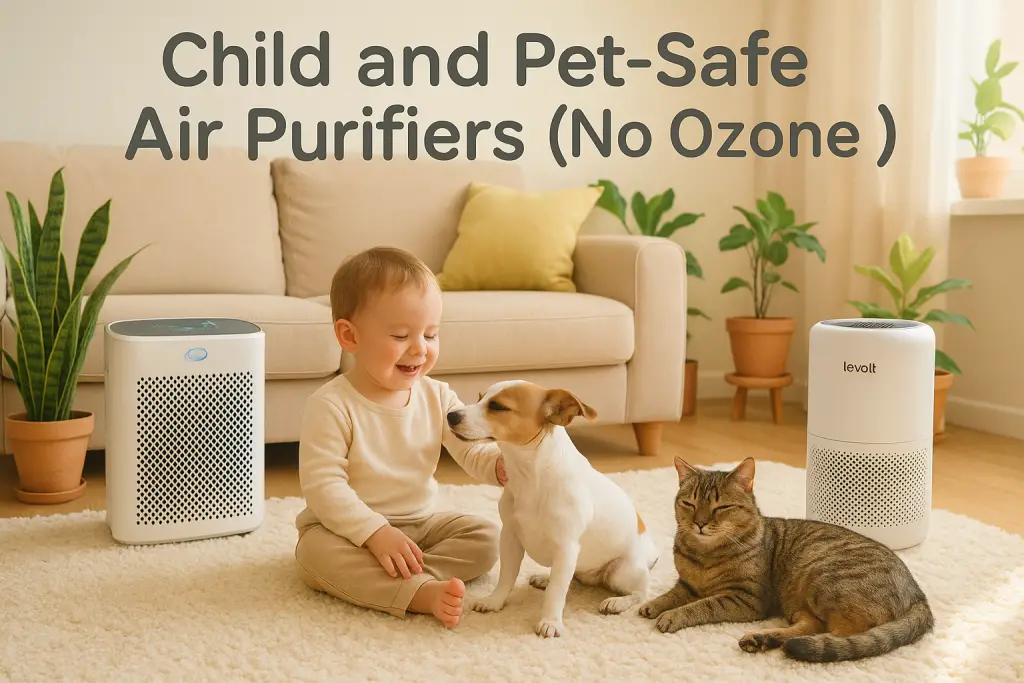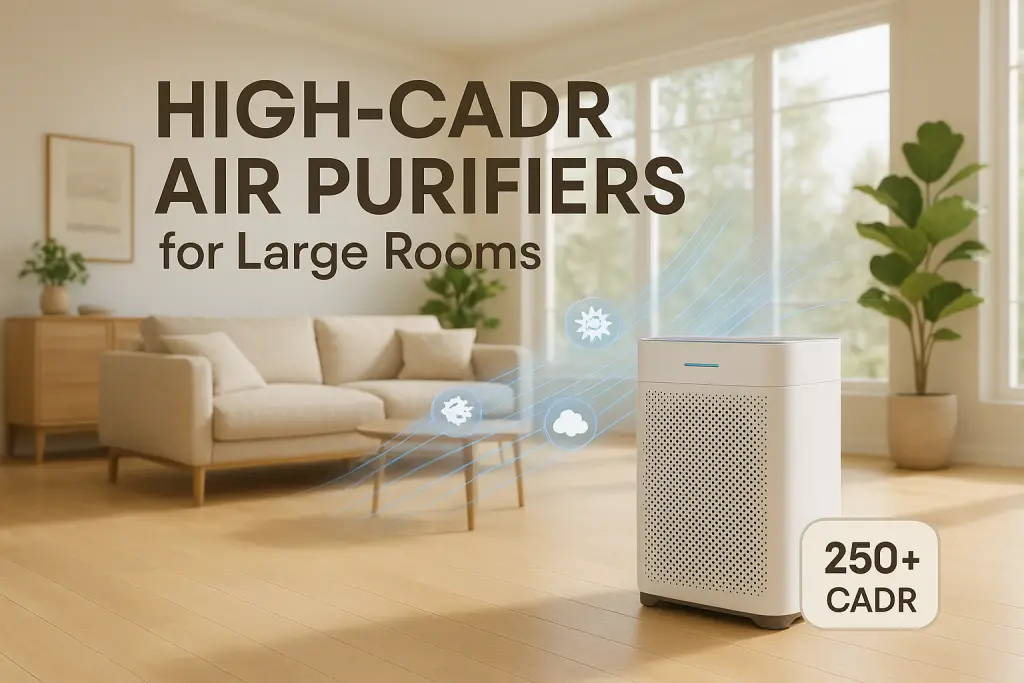Air purifiers can remove VOCs and formaldehyde, but their effectiveness depends on the type of filtration technology they use. Many standard air purifiers with HEPA filters alone cannot adequately address these gaseous pollutants. For effective VOC and formaldehyde removal, you need air purifiers with substantial activated carbon filters or specialized technologies designed specifically for gaseous pollutant removal.
Indoor air quality concerns have increased as modern homes become more airtight and contain more synthetic materials that off-gas these harmful compounds. Understanding how different air purifier technologies tackle these invisible pollutants is essential for making informed decisions about protecting your indoor air quality.
Understanding VOCs and Formaldehyde in Your Home
Before evaluating whether air purifiers can effectively remove VOCs and formaldehyde, it’s important to understand what these compounds are and why they’re concerning. Volatile Organic Compounds (VOCs) are gases emitted from certain solids and liquids that can cause short and long-term health effects. Formaldehyde, a specific type of VOC, is a colorless gas with a strong smell that’s commonly found in many household products and building materials.
These invisible pollutants enter your indoor air through a process called off-gassing, where chemicals slowly release from materials into the air. Unlike dust or pollen, you can’t see these emissions, but they can significantly impact your health and comfort.
Common Sources of VOCs and Formaldehyde in Modern Homes
VOCs and formaldehyde enter your home from numerous sources, many of which might surprise you. Understanding where these pollutants come from is the first step in reducing your exposure.
Building Materials:
- Pressed wood products (particleboard, plywood, MDF)
- Insulation materials
- Adhesives and caulks
- Paints and varnishes
- New flooring, especially vinyl and laminate
Furnishings:
- New furniture, especially those made with pressed wood
- Memory foam mattresses and pillows
- New carpets and carpet padding
- Curtains and fabric treatments
Household Products:
- Air fresheners and scented products
- Cleaning supplies and disinfectants
- Dry-cleaned clothing
- Personal care products
- Hobby materials (glues, paints, solvents)
Most of these sources emit the highest levels of VOCs when they’re new, with emissions typically decreasing over time. However, some products like air fresheners and cleaning supplies release VOCs with each use. Identifying and reducing formaldehyde sources in your home is crucial for maintaining healthy indoor air quality.
Health Effects of VOC and Formaldehyde Exposure
Exposure to VOCs and formaldehyde can cause both immediate symptoms and potential long-term health effects, particularly for sensitive individuals. The EPA classifies formaldehyde as a probable human carcinogen, making exposure reduction a significant health concern.
Short-term symptoms include:
- Eye, nose, and throat irritation
- Headaches and dizziness
- Nausea or vomiting
- Worsening asthma symptoms
- Allergic skin reactions
- Difficulty breathing
Long-term health concerns include:
- Respiratory problems
- Liver and kidney damage
- Central nervous system damage
- Potential increased cancer risk
Children, elderly individuals, and people with pre-existing respiratory conditions like asthma are particularly vulnerable to these pollutants. For those with chronic conditions, following specific air purifier protocols for allergies and asthma can help manage symptoms and improve quality of life.
How Air Purifiers Work to Remove VOCs and Formaldehyde
Not all air purifiers are created equal when it comes to removing gaseous pollutants like VOCs and formaldehyde. The effectiveness depends entirely on the filtration technology employed. To understand whether air purifiers remove VOCs and formaldehyde, you need to understand the mechanisms behind different air cleaning technologies.
The primary air purifier technologies for addressing VOCs include:
Understanding Adsorption: How Activated Carbon Captures VOCs
Activated carbon is the primary technology used for VOC and formaldehyde removal in air purifiers, working through a process called adsorption. Unlike absorption (where liquids are soaked up), adsorption occurs when gas molecules adhere to the surface of a solid material.
Activated carbon works like a molecular magnet for VOCs and formaldehyde. Its structure contains millions of microscopic pores, creating a massive surface area within a small volume. Just one pound of quality activated carbon can have a surface area equivalent to 60 acres!
When air passes through an activated carbon filter:
- Gas molecules come into contact with the carbon surface
- Molecular attraction forces cause VOCs to stick to the carbon
- The clean air continues through while VOCs remain trapped
The effectiveness depends on several factors:
- Carbon quantity: More carbon means more capacity for VOC removal
- Carbon quality: Higher-grade carbons provide better adsorption
- Contact time: Slower airflow allows more thorough adsorption
- Specific treatments: Some carbons are treated to target specific gases like formaldehyde
Once the carbon becomes saturated with pollutants, it loses effectiveness and requires replacement. This happens without visual indicators, making proper air purifier maintenance and filter replacement schedules crucial for continued VOC removal.
Emerging Technologies: PECO, PCO, and Other Advanced VOC Removal Methods
Beyond traditional activated carbon, several newer technologies have emerged that claim to destroy rather than simply capture VOCs and formaldehyde. These technologies take different approaches to breaking down gaseous pollutants into harmless components.
Photocatalytic Oxidation (PCO):
- Uses UV light and a catalyst (usually titanium dioxide)
- Creates hydroxyl radicals that break down VOC molecules
- Can destroy a wide range of gaseous pollutants
- May produce by-products if oxidation is incomplete
Photoelectrochemical Oxidation (PECO):
- Enhanced version of PCO technology
- Uses light-activated nanocatalyst to generate oxidizing species
- Claims more complete destruction of VOCs with fewer by-products
- Newer technology with emerging research
Ozone-Free Plasma:
- Creates charged particles that break down VOC molecules
- Works without filters but often combined with other filtration
- Effectiveness varies widely between implementations
- Important to verify it doesn’t produce harmful ozone
Some smart air purifiers now include app controls and monitoring features that track VOC levels and adjust purification settings automatically. However, the underlying technology still determines actual VOC removal effectiveness, regardless of smart features.
Types of Air Purifiers and Their Effectiveness for VOCs
The market offers several types of air purifiers that claim to remove VOCs and formaldehyde, but their actual effectiveness varies significantly based on technology and design. When asking “do air purifiers remove VOCs and formaldehyde,” the answer depends entirely on the specific type of purifier.
| Air Purifier Type | VOC Removal Effectiveness | Formaldehyde Removal | Key Considerations |
|---|---|---|---|
| HEPA-only Purifiers | Very Poor | Ineffective | Cannot capture gases; only particles |
| Basic Carbon Filters (small amount) | Poor to Moderate | Limited | Quickly saturates; needs frequent replacement |
| Substantial Carbon Filters (1+ lbs) | Good to Very Good | Moderate | Effective but requires regular replacement |
| Chemically Treated Carbon | Good | Very Good | Specially treated for formaldehyde capture |
| HEPA + Substantial Carbon | Very Good | Moderate to Good | Handles both particles and gases |
| PCO/PECO Systems | Moderate to Good | Moderate to Good | Destroys rather than captures; may produce by-products |
Activated Carbon Air Purifiers: The Gold Standard for VOC Removal
Among all air purifier technologies, properly designed activated carbon filtration systems remain the most reliable and effective solution for VOC and formaldehyde removal. The key factor is the quantity and quality of activated carbon in the system.
Carbon quantity matters significantly:
- Small carbon filters (under 1 pound): Limited capacity, quick saturation
- Medium carbon filters (1-3 pounds): Good for moderate VOC levels
- Large carbon filters (5+ pounds): Best for significant VOC issues
For serious VOC and formaldehyde concerns, look for air purifiers with at least 5-10 pounds of activated carbon. Units designed specifically for chemical sensitivity often contain 15+ pounds of carbon and are considerably larger and heavier than standard consumer models.
The carbon filter’s depth also affects performance. Thin carbon filters allow air to pass through quickly, reducing contact time and adsorption efficiency. Deeper carbon beds force longer contact between air and carbon, improving VOC capture.
Some manufacturers enhance their carbon with special treatments to target specific pollutants like formaldehyde. These specialized carbons can significantly improve formaldehyde removal compared to standard activated carbon.
However, remember that all carbon filters have a finite capacity. Once saturated, they stop removing VOCs and require replacement, regardless of how high-quality they initially were.
HEPA Filters and VOCs: Understanding the Limitations
While HEPA filters are excellent for particulate matter, they offer virtually no protection against VOCs and formaldehyde—a crucial distinction many consumers misunderstand. When asking “do air purifiers remove VOCs and formaldehyde,” it’s important to understand why HEPA technology alone cannot address these pollutants.
HEPA (High Efficiency Particulate Air) filters work by physically trapping particles as small as 0.3 microns with an efficiency of 99.97%. They excel at removing dust, pollen, pet dander, mold spores, and many bacteria. However, VOCs and formaldehyde exist as gas molecules measuring around 0.0001 microns—far too small for HEPA filtration.
Think of it like using a chain-link fence to stop water. Just as water molecules easily pass through the fence’s openings, gas molecules pass freely through a HEPA filter’s fibers. This physical limitation cannot be overcome by better HEPA design; it’s a fundamental constraint of the technology.
Many manufacturers add a thin layer of carbon to their HEPA filters and claim “VOC removal.” However, these token carbon layers typically contain only a few ounces of carbon—far too little for meaningful VOC reduction in most environments.
For comprehensive air quality management, high CADR air purifiers that efficiently clean large rooms should combine both HEPA filtration for particles and substantial carbon for VOCs.
Measuring Effectiveness: How Well Do Air Purifiers Actually Remove VOCs?
Laboratory testing and real-world studies provide insight into how effectively air purifiers remove VOCs and formaldehyde from indoor environments. Research shows that properly designed air purifiers can significantly reduce VOC concentrations, though results vary widely based on multiple factors.
Studies measuring VOC removal effectiveness typically show:
- High-quality carbon filters: 50-90% reduction in total VOCs, depending on specific compounds
- Formaldehyde-specific filters: 60-80% reduction in formaldehyde levels
- PCO/PECO technologies: 30-70% reduction, varying by implementation
However, real-world performance often differs from laboratory results due to:
- Continuous VOC emission from sources in the home
- Room size and air change rate variations
- Carbon filter saturation over time
- Temperature and humidity fluctuations
- Competition between different VOC compounds for adsorption sites
A key limitation of all air purifiers is their inability to remove VOCs that are actively being emitted. If you continue using products that release VOCs (like air fresheners or cleaning chemicals), even the best air purifier will struggle to keep up with ongoing emissions.
Time required for significant VOC reduction varies based on room size, purifier capacity, and initial concentration levels. In controlled studies, properly sized air purifiers achieved 50% VOC reduction within 30 minutes to 2 hours, with continued improvement over 12-24 hours of operation.
Testing Your Air Purifier’s VOC Removal Performance
Unlike particle filtration, which can be visualized, VOC removal is invisible—but there are several ways to verify your air purifier is effectively removing these gaseous pollutants.
Consumer-level VOC testing options:
- Basic VOC monitors ($100-300): Provide general VOC readings without identifying specific compounds
- Formaldehyde test kits ($30-100): Single-use tests that measure formaldehyde specifically
- Advanced air quality monitors ($200-500): Track VOC trends over time, often with smartphone connectivity
- Professional testing services ($300-1000): Lab analysis identifying specific VOCs and concentrations
To test your air purifier’s effectiveness:
- Take baseline readings before turning on your purifier
- Run the purifier on high for at least 2 hours
- Take comparative readings in the same location
- Monitor levels over several weeks to track filter saturation
Signs that your carbon filter may be saturated include:
- VOC levels returning to baseline despite purifier operation
- Odors becoming noticeable again after initial improvement
- Chemical smells coming from the purifier itself (breakthrough)
Most carbon filters require replacement every 6-12 months, but high VOC environments may saturate filters much faster. Some specialized purifiers designed for removing cigarette smoke and other strong odors include indicators that monitor filter saturation.
Case Studies: Real-World VOC Reduction Results
Examining real-world scenarios where air purifiers were deployed to address VOC and formaldehyde problems provides valuable insights into actual effectiveness. These case studies demonstrate what realistic results look like in different situations.
Case Study 1: New Construction Home
A family moved into a newly built home and experienced headaches and eye irritation. Testing revealed formaldehyde levels at 70 ppb (parts per billion), above the recommended 40 ppb. They installed two air purifiers with 8 pounds of activated carbon each. After one week of continuous operation, formaldehyde levels decreased to 32 ppb, and symptoms subsided. Monthly testing showed continued improvement over six months as natural off-gassing also decreased.
Case Study 2: Home Office Renovation
After painting and installing new laminate flooring in a home office, VOC levels measured 2,300 μg/m³ (micrograms per cubic meter). A mid-range air purifier with 2 pounds of carbon reduced levels to 1,100 μg/m³ within 24 hours. However, the filter required replacement after just two months. The homeowner’s second filter lasted four months as emission sources aged.
Case Study 3: Chemical Sensitivity Accommodation
A person with Multiple Chemical Sensitivity required VOC levels below 500 μg/m³ to avoid symptoms. Standard air purifiers provided insufficient relief. A specialized unit with 15 pounds of activated carbon and customized for MCS reduced their bedroom VOCs to 320 μg/m³, allowing symptom-free sleep. However, the solution required keeping windows closed and removing all scented products from the room.
These real-world examples highlight both the potential and limitations of using air purifiers for VOC removal. Results vary based on purifier specifications, room conditions, and ongoing sources.
Choosing the Right Air Purifier for VOC and Formaldehyde Removal
Selecting an effective air purifier for VOC and formaldehyde removal requires understanding several key factors beyond marketing claims. When evaluating options, focus on the specifications that directly impact VOC removal capability rather than brand prestige or aesthetic design.
Step 1: Determine your specific needs
- General VOC reduction vs. specific formaldehyde concerns
- Room size and air change requirements
- Current VOC levels (if known) and reduction targets
- Budget constraints for initial purchase and ongoing filter replacement
Step 2: Evaluate carbon filtration specifications
- Carbon quantity: Look for at least 2-5 pounds for average rooms
- Carbon quality: Pelletized carbon typically outperforms fibrous forms
- Carbon bed depth: Deeper beds provide better adsorption efficiency
- Special treatments: Some filters use potassium iodide or other treatments specifically for formaldehyde
Step 3: Consider comprehensive filtration needs
- HEPA filtration for particle removal (dust, pollen, mold spores)
- Pre-filters to extend main filter life
- Filter replacement costs and availability
- Noise levels at different fan speeds
Step 4: Assess additional features and trade-offs
- VOC sensors and auto-mode functionality
- Filter replacement indicators
- Energy consumption
- Size and aesthetics
For bedroom use, consider quiet air purifiers designed specifically for bedroom environments that won’t disturb your sleep while still effectively removing VOCs.
Air Purifier Specifications That Matter for VOC Removal
When evaluating air purifiers for VOC removal, certain specifications are critical while others are merely marketing distractions. Focus on these technical aspects that directly impact VOC removal performance:
Carbon quantity: The single most important specification for VOC removal is the amount of activated carbon in the filter. Look for purifiers that specify carbon weight in pounds:
- Light VOC environments: 1-2 pounds minimum
- Average homes: 2-5 pounds recommended
- High VOC situations: 5-15+ pounds for best results
Carbon type and quality: Not all carbon is equally effective:
- Pelletized/granular carbon: Generally more effective than fiber-based
- Virgin coconut shell carbon: Often provides better adsorption than coal-based
- Acid-washed carbon: Superior purity for better performance
- Chemically treated carbon: Enhanced for specific pollutants like formaldehyde
Air flow rate and residence time: Slower air movement through carbon improves adsorption. Look for:
- Deeper carbon beds (1-3 inches minimum)
- Multiple fan speeds with lower settings for better VOC removal
- Clean Air Delivery Rate (CADR) appropriate for your room size
Filter life indicators: Since carbon saturation isn’t visible, monitoring is important:
- Time-based replacement reminders at minimum
- Weight-sensing technology (advanced units)
- VOC breakthrough detection (specialized units)
Be skeptical of vague marketing terms like “VOC removal technology” without specific carbon quantities. Request this information directly from manufacturers if not clearly stated in product specifications.
Budget Considerations: What to Expect at Different Price Points
Effective VOC removal comes at different price points, with clear trade-offs between initial cost, ongoing maintenance, and performance. Understanding what to expect in each price range helps set realistic expectations.
Entry-Level ($100-300):
- Carbon amount: Usually less than 1 pound
- Effectiveness: Limited VOC reduction, quick filter saturation
- Best for: Light VOC environments, small spaces, temporary use
- Filter replacement: Every 3-6 months ($30-80 per change)
- Limitations: May struggle with formaldehyde specifically
Mid-Range ($300-600):
- Carbon amount: 1-5 pounds typically
- Effectiveness: Moderate to good VOC reduction
- Best for: Average homes, medium-sized rooms, ongoing use
- Filter replacement: Every 6-12 months ($60-150 per change)
- Features: Often include auto modes and basic air quality sensors
Premium ($600-1000+):
- Carbon amount: 5-15+ pounds
- Effectiveness: Substantial VOC and formaldehyde reduction
- Best for: High VOC environments, chemical sensitivity, large spaces
- Filter replacement: Every 12-24 months ($100-300+ per change)
- Features: Advanced monitoring, specialized filtration media, higher quality construction
Specialized Units ($1000-3000+):
- Carbon amount: Often 15-30+ pounds
- Effectiveness: Maximum possible VOC removal
- Best for: Chemical sensitivity, medical requirements, industrial applications
- Filter replacement: Modular designs with separate carbon replacement
- Features: Medical-grade construction, detailed monitoring, customizable media
Consider the total cost of ownership over 5 years, including filter replacements. In high-VOC environments, a more expensive unit with larger carbon capacity may actually be more economical long-term than repeatedly replacing smaller, saturated filters.
Optimizing VOC Removal: Placement, Usage, and Maintenance
Even the best air purifier for VOC removal will underperform if not properly placed, operated, and maintained. Optimizing these factors can significantly improve your results without additional cost.
Strategic placement for maximum effectiveness:
- Position 3-6 feet from walls for proper air circulation
- Place in areas where you spend the most time (bedrooms, living rooms)
- Keep away from obstacles that block airflow
- For bedrooms, position the unit 6-10 feet from your bed
- Avoid corners where air circulation is limited
- Keep doors and windows closed for best results
Optimal operation settings:
- Run continuously rather than intermittently for consistent VOC control
- Use higher fan speeds initially when VOC levels are high
- Consider lower speeds during occupied periods for noise reduction
- For automatic modes, verify the sensor responds to VOCs, not just particles
- Program timers to use higher speeds during unoccupied periods
Maintenance requirements:
- Replace carbon filters according to manufacturer recommendations
- Consider more frequent replacement in high-VOC environments
- Clean pre-filters regularly to maintain airflow
- Check for bypass leakage around filters
- Clean external surfaces and air intake grilles
Running your purifier 24/7 is generally recommended for VOC control. Unlike particulate pollution that settles, VOCs remain airborne and continue to off-gas from sources. Continuous operation provides consistent removal and prevents concentration buildup.
Filter Replacement for VOC Removal: Timing and Indicators
Unlike particle filters that show visible dirt accumulation, carbon filters saturated with VOCs give few visual clues when they need replacement. This makes proper replacement timing critical for maintaining effectiveness.
Average carbon filter lifespan depends on several factors:
- Carbon quantity: Larger carbon beds last longer
- VOC concentration: Higher levels cause faster saturation
- Usage hours: Continuous operation affects lifespan
- Temperature and humidity: Higher levels accelerate saturation
- Competing pollutants: Multiple VOC types compete for adsorption sites
Warning signs of carbon filter saturation:
- Return of odors previously controlled by the purifier
- Symptoms (headaches, irritation) returning despite purifier use
- VOC monitor readings rising despite continuous operation
- Unpleasant smell coming from the purifier itself (breakthrough)
- Reduced effectiveness against new odors introduced
Testing methods to verify continued effectiveness:
- VOC monitor testing before and after filter
- Smoke test: See if odor from a blown-out candle is removed
- Weight comparison: Some users weigh filters to detect saturation
Many manufacturers’ replacement guidelines are overly optimistic. In real-world conditions, carbon filters often require replacement earlier than stated, especially in high-VOC environments. Budget for more frequent replacements if you have significant VOC concerns or recent renovations.
Some advanced users extend filter life by periodically exposing saturated carbon to outdoor air in a clean environment, which can release some captured VOCs. However, this is only marginally effective and doesn’t work for all pollutant types.
Room-Specific Placement Strategies for Maximum VOC Removal
Different rooms present unique challenges for VOC removal, requiring specific placement strategies to maximize effectiveness. Tailoring your approach to each space can significantly improve results.
Bedrooms:
- Position 6-10 feet from the bed, not directly beside it
- Avoid placing between you and the door
- Keep away from curtains that may block airflow
- Consider noise levels when selecting fan speeds
- Use timer functions to increase speeds when room is unoccupied
Living Areas:
- Central placement away from walls is ideal
- Position between major VOC sources and seating areas
- Consider ceiling height when determining coverage
- Don’t place behind furniture or in corners
- For open floor plans, focus on areas with the most occupancy
Kitchens:
- Place away from direct cooking steam and grease
- Position to capture cooking VOCs without blocking workspace
- Consider a pre-filter that can be cleaned frequently
- Use higher fan speeds during and after cooking
Home Offices:
- Position between you and equipment that may emit VOCs
- Keep 3-4 feet from printers and other office equipment
- Ensure airflow isn’t blocked by monitors or furniture
- Consider smaller desktop units as supplements for close-range filtration
Basements:
- Focus on areas with the highest moisture (VOCs adhere to humidity)
- Position away from direct contact with concrete floors
- Elevate slightly in flood-prone areas
- Consider dehumidification as a complementary strategy
For homes with central HVAC systems, consider placing purifiers in rooms without supply vents or where vents are closed. This creates less competition between your purifier and HVAC airflow.
Comprehensive Approach: Beyond Air Purifiers for VOC Control
While air purifiers can be effective, a comprehensive approach to VOC and formaldehyde reduction includes source control, ventilation, and complementary methods. Air purification should be viewed as one component of a multi-faceted strategy for optimal indoor air quality.
The VOC reduction hierarchy (in order of effectiveness):
- Source control: Eliminating or reducing VOC-emitting products
- Ventilation: Diluting indoor pollutants with outdoor air
- Air purification: Removing VOCs from circulating air
- Supplemental methods: Additional techniques for specific scenarios
Following this hierarchy provides more effective and sustainable results than relying solely on air purification. Even the best air purifiers struggle to keep up with active VOC sources, making source control the foundation of any effective strategy.
A comprehensive approach includes:
- Identifying and removing unnecessary VOC sources
- Replacing high-emission products with low-VOC alternatives
- Implementing strategic ventilation during favorable conditions
- Using targeted air purification for remaining pollutants
- Applying supplemental techniques for specific compounds
- Regular monitoring to verify improvement
This integrated approach addresses the root causes of indoor air pollution while using air purification as an important supporting strategy. The combination is far more effective than any single method alone.
Source Control: The Most Effective VOC Reduction Strategy
The most effective way to reduce VOCs and formaldehyde is to minimize their introduction into your home in the first place. Source control should always be your first line of defense against indoor air pollution.
For existing homes, focus on:
- Removing unnecessary scented products (air fresheners, scented candles, incense)
- Switching to fragrance-free cleaning products
- Storing paint, solvents, and chemicals outside living spaces
- Airing out dry-cleaned clothing before bringing indoors
- Using low-VOC cleaning methods (steam, microfiber, vinegar-based cleaners)
- Evaluating furniture and replacing high-emitting pieces when possible
For renovations and new purchases:
- Select solid wood instead of pressed wood products when possible
- Choose low-VOC or zero-VOC paints and finishes
- Look for GreenGuard or similar certifications on furniture
- Select hard flooring over carpeting when possible
- Request no-added-formaldehyde (NAF) materials
- Allow materials to off-gas in garages or outdoor areas before installation
For ongoing protection:
- Establish a “no shoes” policy to reduce tracking in chemicals
- Avoid artificially scented personal care products
- Choose natural fabrics over synthetics when possible
- Read product labels and avoid ingredients like “fragrance” or “parfum”
- Create low-VOC purchasing policies for your household
Remember that no air purifier can keep up with active VOC sources. Eliminating unnecessary sources first makes air purification much more effective at addressing the remaining pollutants.
Ventilation Strategies to Complement Air Purification
Proper ventilation works synergistically with air purification to significantly reduce indoor VOC and formaldehyde levels. Fresh air dilution can rapidly decrease VOC concentrations when outdoor air quality is good.
Natural ventilation techniques:
- Cross-ventilation: Open windows on opposite sides of your home
- Stack effect: Open windows on different floors to create upward airflow
- Morning/evening ventilation when outdoor air quality is best
- Seasonal adjustment based on outdoor pollution and pollen levels
- Short, intense ventilation (15-30 minutes) several times daily
Mechanical ventilation options:
- Exhaust fans in bathrooms and kitchens to remove moisture and cooking VOCs
- Window fans to create directional airflow
- Whole-house fans for rapid air exchange in moderate climates
- Heat Recovery Ventilators (HRVs) for energy-efficient fresh air in cold climates
- Energy Recovery Ventilators (ERVs) for humidity control in humid climates
Strategic ventilation timing:
- After high-emission activities (cooking, cleaning, hobbies)
- During low outdoor pollution periods (check AQI)
- During moderate temperature periods to minimize energy impact
- When pollen counts are low for allergy sufferers
The ideal approach combines scheduled ventilation with air purification. Ventilate when outdoor conditions are favorable, then run air purifiers to handle remaining pollutants and during periods when windows must remain closed.
Some advanced air quality monitors can help determine the best ventilation timing by comparing indoor and outdoor pollution levels. This data-driven approach optimizes the balance between fresh air and filtration.
Special Scenarios: High-VOC Environments and Sensitive Individuals
Certain situations demand enhanced approaches to VOC and formaldehyde removal, particularly for high-concentration environments or sensitive individuals. These scenarios require more aggressive and comprehensive strategies beyond standard recommendations.
New construction and major renovations:
- Delay occupancy when possible (2-4 weeks minimum)
- Implement pre-occupancy bake-out procedures (elevated temperature with ventilation)
- Use multiple high-capacity air purifiers with substantial carbon
- Consider professional-grade equipment rental for initial period
- Implement regular testing to track VOC reduction
- Focus first on sleeping areas, then expand to other spaces
Chemical sensitivity accommodation:
- Create designated low-VOC zones within the home
- Use specialized air purifiers designed specifically for MCS (Multiple Chemical Sensitivity)
- Implement strict source control protocols
- Consider VOC-absorbing building materials (specialized drywall, clay plasters)
- Establish clean entry protocols to prevent outside chemical intrusion
- Use VOC monitoring to verify safe levels
Emergency high-VOC scenarios (paint spills, chemical exposure):
- Prioritize ventilation first (create maximum airflow)
- Remove affected materials if possible
- Use multiple air purifiers at highest settings
- Consider temporary relocation if levels remain high
- Monitor for safe re-entry conditions
These special scenarios often require consulting with indoor air quality professionals to develop customized approaches. The standard consumer solutions may be insufficient for these challenging situations.
VOC Removal for Sensitive Populations: Children, Elderly, and Those with Respiratory Conditions
Children, elderly individuals, and those with asthma or chemical sensitivities require more stringent VOC control measures and specialized approaches. These vulnerable populations often react to lower concentrations of pollutants and need enhanced protection.
For children’s rooms and nurseries:
- Select furnishings specifically with low chemical emissions
- Allow new furniture and materials to off-gas elsewhere for 2-4 weeks
- Use air purifiers with substantial carbon but quiet operation
- Position purifiers away from cribs but within the same airspace
- Consider running purifiers at higher speeds when room is unoccupied
- Avoid all scented baby products, including wipes and lotions
For elderly individuals:
- Recognize that sensitivity often increases with age
- Focus on sleeping areas where most time is spent
- Select easy-to-use air purifiers with simple controls
- Implement automatic filter replacement programs
- Consider quieter units as hearing sensitivity may make noise stressful
- Ensure purifiers don’t create tripping hazards
For asthma and respiratory conditions:
- Use comprehensive purifiers that address both particles and gases
- Create clean air zones for symptom relief during flare-ups
- Consider medical-grade filtration for severe conditions
- Monitor both particulate matter and VOCs
- Coordinate air quality strategies with healthcare providers
- Keep rescue medications accessible
For multiple chemical sensitivity:
- Use specialized purifiers designed specifically for extreme sensitivity
- Consider sealed carbon beds rather than carbon blends
- Implement strict fragrance-free home policies
- Create “safe rooms” with comprehensive filtration
- Use airlock entry systems for severe cases
- Work with environmental medicine specialists
The key principle is creating safer spaces first, then gradually expanding the protected areas. Focus initial efforts on sleeping areas where people spend 8+ hours daily, then extend to other frequently used spaces.
New Construction and Renovation: Managing High Formaldehyde Levels
New construction and renovation projects create temporarily elevated VOC and formaldehyde levels that require specific strategies beyond standard air purification. These situations present some of the highest indoor VOC concentrations you’ll encounter.
Timeline-based approach for new construction:
- Pre-occupancy phase (1-4 weeks):
- Maximum ventilation with doors and windows open
- Temperature elevation to 80-85°F if possible (accelerates off-gassing)
- Dehumidification to 40-50% (reduces VOC binding to surfaces)
- Industrial air scrubbers if available
- Initial occupancy phase (first 2-3 months):
- Multiple high-capacity air purifiers with substantial carbon (10+ pounds total)
- Continued aggressive ventilation when weather permits
- VOC monitoring to track improvement
- Limited time in the space if levels remain high
- Stabilization phase (3-6 months):
- Transition to long-term air purification strategy
- Regular filter replacement schedule
- Continued monitoring until levels stabilize
- Targeted treatment of any remaining hotspots
Material selection to minimize emissions:
- Specify low-VOC or zero-VOC paints and finishes
- Select solid wood over pressed wood products when possible
- Choose NAF (no added formaldehyde) or ULEF (ultra-low emitting formaldehyde) materials
- Request manufacturers’ test results for emission levels
- Look for GreenGuard Gold, FloorScore, or similar certifications
- Consider formaldehyde-sequestering drywall products
Post-renovation specific strategies:
- Use box fans in windows to exhaust polluted air
- Clean all surfaces to remove construction dust (which can absorb and re-release VOCs)
- Replace HVAC filters with high-efficiency models
- Consider duct cleaning if HVAC was operating during renovation
- Monitor the space before resuming full occupancy
For occupied renovations, create containment zones with plastic sheeting and negative pressure (exhaust fans blowing outward) to prevent VOCs from spreading throughout the home.
Frequently Asked Questions About Air Purifiers and VOCs
Below we address the most common questions about air purifiers and their effectiveness against VOCs and formaldehyde.
Does a HEPA filter remove formaldehyde?
No, HEPA filters cannot remove formaldehyde or other VOCs. HEPA filtration targets particles 0.3 microns and larger through physical trapping, while formaldehyde exists as a gas with molecules approximately 0.0001 microns in size. These gas molecules easily pass through HEPA filter material. For formaldehyde removal, you need activated carbon filters, preferably with special treatment for formaldehyde adsorption, or other gas-phase filtration technology.
How long does it take an air purifier to remove VOCs?
The time required depends on several factors: room size, air purifier capacity, VOC concentration, and ongoing emissions. In controlled studies with properly sized purifiers, VOC reduction typically follows this pattern: 20-30% reduction within 30 minutes, 50-60% reduction within 2-3 hours, and 70-80% reduction after 12-24 hours of continuous operation. However, if VOC sources remain active, complete removal isn’t possible, and levels will stabilize at a reduced concentration rather than reaching zero.
Can air purifiers remove cooking odors and fumes?
Yes, quality air purifiers with substantial activated carbon can effectively reduce cooking odors and fumes, which contain various VOCs. For best results, use purifiers with at least 2-5 pounds of activated carbon and position them near but not directly beside cooking areas. Kitchen purifiers should also include effective pre-filters to handle grease particles. Running the purifier during and for 1-2 hours after cooking provides the best odor reduction.
Are plants effective at removing formaldehyde?
Plants have limited effectiveness for formaldehyde removal in real-world conditions. While NASA studies showed certain plants can absorb formaldehyde in sealed chambers, their impact in typical homes is minimal. Research indicates you would need approximately 10-20 plants per 100 square feet to achieve meaningful formaldehyde reduction. Plants provide many benefits but shouldn’t be relied upon as a primary VOC control strategy. Air purifiers with activated carbon are much more efficient and predictable for formaldehyde removal.
What’s better for VOCs: air purifiers or ventilation?
The answer depends on outdoor air quality and specific circumstances. Ventilation typically removes VOCs faster when outdoor air is clean but introduces outdoor pollutants and affects temperature control. Air purifiers work continuously regardless of outdoor conditions but remove VOCs more slowly. The ideal approach combines both: use ventilation when outdoor air quality is good and temperature is comfortable, then rely on air purifiers during unfavorable outdoor conditions or extreme temperatures. For ongoing protection, this combined approach is most effective.
How do I know when my carbon filter needs replacement?
Unlike particle filters that show visible dirt, carbon filter saturation isn’t visible. Signs indicating replacement is needed include: return of odors previously controlled by the purifier, VOC levels rising despite purifier operation, unpleasant smells coming from the purifier itself (breakthrough), or diminished effectiveness against new odors. For more precise assessment, use a VOC monitor to test purifier performance periodically. Generally, carbon filters need replacement every 6-12 months in average conditions, but high-VOC environments may saturate them in 3-6 months.
Conclusion: Making Informed Decisions About VOC and Formaldehyde Removal
Effectively managing VOCs and formaldehyde requires understanding both the capabilities and limitations of air purifiers as part of a comprehensive approach. The question “do air purifiers remove VOCs and formaldehyde?” has a nuanced answer: yes, they can, but only when properly designed with appropriate filtration technology and used as part of a broader strategy.
Key takeaways from our comprehensive exploration:
- Activated carbon is the primary effective technology for VOC and formaldehyde removal
- Carbon quantity matters significantly—look for purifiers with substantial carbon (2+ pounds)
- HEPA filters alone cannot remove gaseous pollutants like VOCs
- Source control should always be your first line of defense
- Strategic ventilation complements air purification effectively
- Special situations like new construction or chemical sensitivity require enhanced approaches
- All carbon filters eventually saturate and require replacement
For most homes, a multi-layered approach works best:
- Eliminate unnecessary VOC sources (air fresheners, scented products)
- Ventilate regularly when outdoor conditions permit
- Use appropriately sized air purifiers with substantial activated carbon
- Monitor filter performance and replace as needed
- Consider room-specific strategies for bedrooms, living areas, and other spaces
By implementing this comprehensive approach, you can significantly reduce your exposure to VOCs and formaldehyde, creating a healthier indoor environment. Air purifiers are valuable tools in this process, but they work best when deployed as part of a thoughtful, integrated strategy rather than as a standalone solution.
| Photo | Air Purifier Model | Best for | Price |
|---|---|---|---|

|
WINIX A231 Air Purifier | Asthma & Indoor Pollution | Check Price On Amazon |

|
Rabbit Air, A3 SPA-1000N Air Purifier | Pet Dander & Odors | Check Price On Amazon |

|
LEVOIT Air Purifier | Best Overall | Check Price On Amazon |

|
GermGuardian Air Purifier | Cigarette & Cooking Smoke | Check Price On Amazon |

|
Coway Airmega Air Purifier | New-borns | Check Price On Amazon |

|
BLUEAIR Air Purifier | Germ & Virus Control | Check Price On Amazon |
